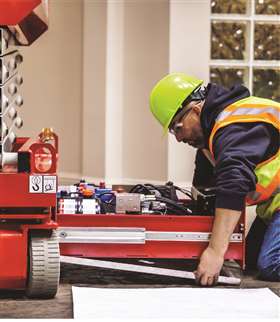MEC debuts Leak Containment System
18 June 2019

MEC Aerial Work Platforms has debuted the patent-pending Leak Containment System (LCS). LCS was developed for easy installation and leak detection through its design with pre-cut absorbent pads for quick replacement. Through the system’s strategically placed inspection holes, a leak can be detected and the absorbent pads can be removed and replaced.
It was MEC’s investigation into hydraulic oil leaks that found the majority of leaks come from the hydraulic motors on the front wheels that are constantly stressing the hoses with steering functions. MEC’s slab scissor line is direct electric drive, eliminating the drive wheels as a source of oil leaks. With a system of trays integrated into MEC slab scissor lifts to contain leaks, LCS delivers a better solution to operating machines on surfaces that require protection.
LCS is integrated within the unit to avoid interference with critical machine functions including deployment of the pothole protection system, static strap utility and front wheel operation. With LCS incorporated inside the machine instead of attached around the chassis, there is unrestricted access to the emergency stop button, emergency lowering functions and the base controls. The integrated trays are protected from damage due to jobsite debris, forklift handling and weather elements that can compromise leak containment, according to MEC.
“MEC thrives on learning our customer’s pain points and creating a better solution to eliminate them,” said Vice President of Engineering Gary Crook. “LCS is the perfect result of that.”




